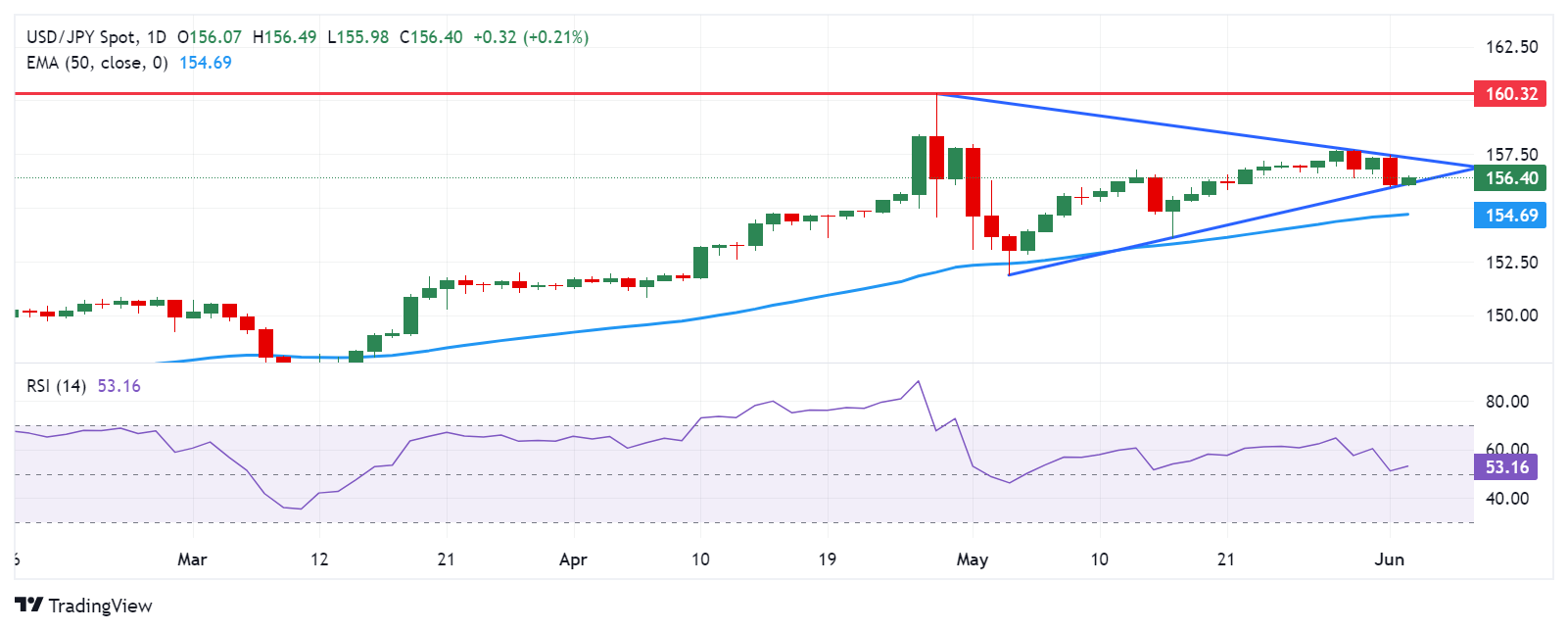- The Japanese Yen appreciates as the Fed expects to deliver a rate cut in 2024.
- BoJ Governor Kazuo Ueda stated that the central bank may increase rates if underlying inflation accelerates as expected.
- The US Dollar remains stable due to the upward correction in US Treasury yields.
The Japanese Yen (JPY) extends its gains for the second successive session on Tuesday due to risk-on sentiment. This could be attributed to the growing expectations of interest rate cuts by the Federal Reserve (Fed) in 2024. This sentiment is reinforced by the unexpected drop in the ISM Manufacturing PMI. However, the interest rate differential between the US and Japan continued to pressure the Yen, limiting the downside of the USD/JPY pair.
Bank of Japan (BoJ) Governor Kazuo Ueda said on Tuesday that the central bank will conduct "nimble" market operations if long-term interest rates spike, signaling the BoJ's readiness to ramp up bond buying when necessary. Ueda also stated that the BoJ will adjust the degree of monetary support if underlying inflation accelerates in line with its forecast, per Reuters.
US Dollar Index (DXY), which measures the value of the US Dollar (USD) against six other major currencies, edges higher with the improvement in US Treasury yields. This uptick can be linked to a prevalent risk-averse mood before the release of Wednesday's ADP Employment Change and ISM Services PMI data. Despite expectations that the Federal Reserve (Fed) won't pursue further interest rate hikes, putting downward pressure on US Treasury yields, this could potentially weaken the Greenback.
Daily Digest Market Movers: Japanese Yen gains ground due to improved risk sentiment
- Reuters reported on Tuesday that Japan's government will highlight the challenges a weak Yen poses for households in this year's long-term economic policy roadmap. This focus on the Yen's impact is expected to maintain pressure on the Bank of Japan to either raise interest rates or reduce its extensive bond-buying program.
- The ISM Manufacturing PMI unexpectedly dropped to 48.7 in May, down from April's reading of 49.2 and below the forecast of 49.6. The US manufacturing sector experienced its second consecutive month of contraction, marking the 18th time in the last 19 months.
- Reuters reported on Monday that Japanese Economy Minister Yoshitaka Shindo announced that the government will “continue efforts for primary balance to reach within surplus territory in FY 2025.” Shindo also expressed optimism, stating that “Real economic growth of 1.3% in FY 2025 is not so unrealistic.”
- Japan's Tokyo Consumer Price Index (CPI), released on Friday, rose to 2.2% year-over-year in May, up from April's 1.8% rise. If nationwide inflation in Japan were to decline, it would likely deter the Bank of Japan (BoJ) from raising interest rates.
- In an interview with Fox Business on Thursday, Atlanta Fed President Raphael Bostic stated that he does not think additional rate increases are necessary to achieve the Fed's 2% annual inflation target. Furthermore, New York Fed President John Williams stated as per Reuters that inflation is currently too high but should start to decline in the second half of 2024. Williams believes that monetary policy action is not urgently needed.
Technical Analysis: USD/JPY trades around 156.50
The USD/JPY pair traded near 156.40 on Tuesday. Analysis of the daily chart shows a symmetrical triangle pattern, signaling a period of consolidation. However, the 14-day Relative Strength Index (RSI) remains slightly above 50 level, a decline may suggest a potential momentum shift toward a bearish bias.
Regarding potential price movements, if the USD/JPY pair breaks above the psychological barrier of 157.00 and surpasses the upper boundary of the symmetrical triangle, it could find support to retest 160.32, its highest level in over thirty years.
Conversely, if the pair breaches the lower boundary of the symmetrical triangle, it may face downward pressure, approaching the psychological level of 156.00. Further downside could lead to testing the 50-day Exponential Moving Average (EMA) at 154.69.
USD/JPY: Daily Chart
Japanese Yen price today
The table below shows the percentage change of the Japanese Yen (JPY) against listed major currencies today. Japanese Yen was the weakest against the US Dollar.
| USD | EUR | GBP | CAD | AUD | JPY | NZD | CHF | |
| USD | 0.24% | 0.26% | 0.37% | 0.59% | -0.51% | 0.35% | -0.02% | |
| EUR | -0.24% | 0.02% | 0.12% | 0.34% | -0.74% | 0.11% | -0.26% | |
| GBP | -0.28% | -0.02% | 0.10% | 0.33% | -0.76% | 0.10% | -0.27% | |
| CAD | -0.37% | -0.12% | -0.11% | 0.22% | -0.88% | -0.01% | -0.38% | |
| AUD | -0.57% | -0.34% | -0.33% | -0.21% | -1.09% | -0.21% | -0.60% | |
| JPY | 0.48% | 0.74% | 0.76% | 0.84% | 1.08% | 0.83% | 0.49% | |
| NZD | -0.35% | -0.11% | -0.10% | 0.01% | 0.23% | -0.86% | -0.37% | |
| CHF | 0.02% | 0.26% | 0.28% | 0.38% | 0.63% | -0.48% | 0.37% |
The heat map shows percentage changes of major currencies against each other. The base currency is picked from the left column, while the quote currency is picked from the top row. For example, if you pick the Euro from the left column and move along the horizontal line to the Japanese Yen, the percentage change displayed in the box will represent EUR (base)/JPY (quote).
Japanese Yen FAQs
The Japanese Yen (JPY) is one of the world’s most traded currencies. Its value is broadly determined by the performance of the Japanese economy, but more specifically by the Bank of Japan’s policy, the differential between Japanese and US bond yields, or risk sentiment among traders, among other factors.
One of the Bank of Japan’s mandates is currency control, so its moves are key for the Yen. The BoJ has directly intervened in currency markets sometimes, generally to lower the value of the Yen, although it refrains from doing it often due to political concerns of its main trading partners. The current BoJ ultra-loose monetary policy, based on massive stimulus to the economy, has caused the Yen to depreciate against its main currency peers. This process has exacerbated more recently due to an increasing policy divergence between the Bank of Japan and other main central banks, which have opted to increase interest rates sharply to fight decades-high levels of inflation.
The BoJ’s stance of sticking to ultra-loose monetary policy has led to a widening policy divergence with other central banks, particularly with the US Federal Reserve. This supports a widening of the differential between the 10-year US and Japanese bonds, which favors the US Dollar against the Japanese Yen.
The Japanese Yen is often seen as a safe-haven investment. This means that in times of market stress, investors are more likely to put their money in the Japanese currency due to its supposed reliability and stability. Turbulent times are likely to strengthen the Yen’s value against other currencies seen as more risky to invest in.
Information on these pages contains forward-looking statements that involve risks and uncertainties. Markets and instruments profiled on this page are for informational purposes only and should not in any way come across as a recommendation to buy or sell in these assets. You should do your own thorough research before making any investment decisions. FXStreet does not in any way guarantee that this information is free from mistakes, errors, or material misstatements. It also does not guarantee that this information is of a timely nature. Investing in Open Markets involves a great deal of risk, including the loss of all or a portion of your investment, as well as emotional distress. All risks, losses and costs associated with investing, including total loss of principal, are your responsibility. The views and opinions expressed in this article are those of the authors and do not necessarily reflect the official policy or position of FXStreet nor its advertisers. The author will not be held responsible for information that is found at the end of links posted on this page.
If not otherwise explicitly mentioned in the body of the article, at the time of writing, the author has no position in any stock mentioned in this article and no business relationship with any company mentioned. The author has not received compensation for writing this article, other than from FXStreet.
FXStreet and the author do not provide personalized recommendations. The author makes no representations as to the accuracy, completeness, or suitability of this information. FXStreet and the author will not be liable for any errors, omissions or any losses, injuries or damages arising from this information and its display or use. Errors and omissions excepted.
The author and FXStreet are not registered investment advisors and nothing in this article is intended to be investment advice.
Recommended content
Editors’ Picks

AUD/USD stays firm near 0.6300 amid modest risk appetite
AUD/USD is posting small gains near 0.6300 in early Asian trades on Monday, opening the week on the front foot. Risk sentiment remains in a sweeter spot following the weekend's news of lower US tariffs on Chinese electronic supply chain. Tariffs talks will remain on the radar.

USD/JPY rises above 143.50 at the weekly opening
USD/JPY is trading well bid above 143.50 amid a positive start to the Holy Friday week. The US Dollar holds the rebound from multi-year troughs, digesting Trump's tariff news from the weekend. The Fed-BoJ policy divergence expectations will keep the Japanese Yen supported, limiting the pair's upside.

Gold retreats from record highs of $3,245 as US Dollar finds its feet
Gold is rereating from record highs of $3,245 early Monday, extending Friday's late pullback. Reducded demand for safe-havens and a broad US Dollar rebound undermine the yellow metal amid the news of not-so-steep US tariffs on China's semiconductors and electronics.

Week ahead: ECB set to cut, BoC might pause as Trump U-turns on tariffs
ECB is expected to trim rates, but the BoC might pause this time. CPI data also in the spotlight; due in UK, Canada, New Zealand and Japan. Retail sales the main release in the United States. China GDP eyed as Beijing not spared by Trump.

Is a recession looming?
Wall Street skyrockets after Trump announces tariff delay. But gains remain limited as Trade War with China continues. Recession odds have eased, but investors remain fearful. The worst may not be over, deeper market wounds still possible.

The Best brokers to trade EUR/USD
SPONSORED Discover the top brokers for trading EUR/USD in 2025. Our list features brokers with competitive spreads, fast execution, and powerful platforms. Whether you're a beginner or an expert, find the right partner to navigate the dynamic Forex market.




